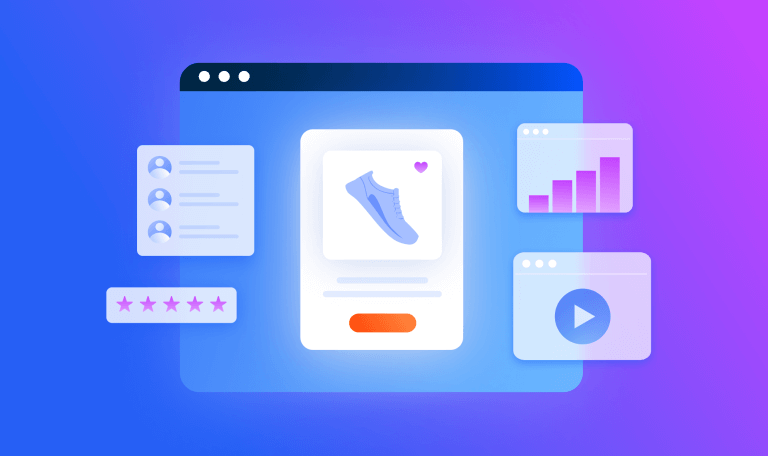10 years of eCommerce penetration in 90 days: How the customer buying journey has changed

By now it’s become a cliché to say, but the pandemic’s effect on consumer habits and expectations was truly a radical one.
The apparel industry felt this pain in particular. From knocks to consumer coffers, to forced closures for physical retailers in many countries, the industry was inevitably in for a wild ride.
In-store shopping dropped to zero almost immediately. For the luxury category, this was particularly painful given that consumers conduct close to 95% of purchases in-store.
The closure of physical stores, and a rising fear of public spaces, drove even the least digitally savvy among us online. The result of which was the formation of new habits and expectations that have shifted the buying journey.
In this blog, we’ll deep dive into the new customer buying journey. First, we’ll take a look at where the focus has shifted to, the rising stars and fallen angels of the company-consumer interaction world, before subsequently analyzing shifts in expectation across both online and offline touchpoints.
10 years of eCommerce penetration in 90 days means a permanent increase in the use of digital touchpoints
We’ve never seen such an acceleration in digital adoption as we have this year.
In 90 days, we’ve vaulted forward 10 years in eCommerce penetration and there was a 30% increase in the top eCommerce companies spending from March to mid-April in the US alone.
New habits are formed over long periods of time and are reinforced by practice. COVID-19 provided adequate quantities of both, forcing buyers online and teaching even the least digitally savvy of us what to expect from the digital shopping experience.
Immersion in the immediacy, convenience, and safety of online shopping means that, although retail is likely to rebound and recapture sales volume, we have likely seen a permanent shift.
So, digital is king. It was already happening but it truly happened in the first 90 days of the COVID-19 outbreak.
Without the usual in-store experience, the apparel industry will have to change everything, from operations and hiring new skill sets to positioning against new competitors.
Brands should aim to make their digital experience “smashable”—a term that comes from the idea of smashing a Coca-Cola bottle and still being able to identify the brand.
Every customer journey stage needs to be unique to the brand and instantly recognizable.
The virtual experience
A rising star in the ‘awareness’ stage is the digital events agenda.
A quick flip to valuable, entertaining digital events acts as a powerful customer retention tool at a time when there are fewer physical opportunities to interact.
One remarkable example comes from Nike, who dialed up their digital fitness offering in China in early March.
Nike saw an 80% increase in weekly active users on its Nike Training Club app, which, in turn, translated into “strong engagement” with the Nike commerce app and a subsequently positive earnings report for the quarter.
The Lululemon app doubled down on digital, too. During the first week of store closures, the women’s clothing company saw 170,000 people join their live classes and saw a 40% hike in digital sales in the last quarter.
Click & collect is here to stay
Another growing touchpoint is the use of click & collect. Used by many to reduce the amount of time spent in-store, the service has risen as a trigger for store visits.
Research suggests click-and-collect visits increase in-store upsell opportunities. Consumers eager to avoid crowded places still visit to collect their items—which has become a vital time for retailers to capture their attention.
User growth of click and collect has grown 34% in both the US and the UK, and surveys indicate that 59% of users intend to continue this habit change post-Coronavirus.
Customers are keen to embrace the click-and-collect model because it offers them the immediate gratification of quickly getting a purchase combined with cost savings on delivery. It also avoids the painful saga of missing the delivery and having to pick it up at the local mail depot.
A number of eCommerce brands have invested in expanding options in this area. For example, Schuh, the British high-street footwear retailer, has five delivery options, which include in-store pickup and pick up at local supermarkets.
Outdoor advertising has taken a permanent hit in particular areas
Foot traffic has undoubtedly fallen, as people opt for countryside walks, working from home, and shopping online.
And even now that we’re seeing the opening of shops and restaurants, it’s unlikely the demand for in-store shopping will rebound entirely.
Consumers now prefer to spend less time in riskier environments, which include physical stores and public transport. Many city centers are finding it hard to find a balance between car parking spaces and more space for pedestrians, outdoor restaurants, and marketplaces.
Out-of-home (OOH) advertising, the name for advertising that reaches consumers outside their homes, also took a hit during the pandemic.
OOH, ad-giant JCDecaux took a 66% reduction in revenue in the second quarter of 2020. A result of both a hit to the marketing budget of faint-hearted marketing departments and a strategic withdrawal due to the reduction in people commuting to work.
However, it appears advertisers expect to only lose their grasp on more sparsely populated places. Advertisers are still hopeful that cities will remain relevant to companies as advertising spaces, despite the fall in suburban and countryside spaces.
8 new expectations along the customer buying journey
There was no predicting the dramatic shift in focus that happened over the pandemic. Touchpoints that were skirting around the periphery of the apparel marketers’ minds suddenly became a priority.
In fact, almost every part of the buying journey, from awareness through to advocacy saw a shift in volume and expectation.
How expectations along the digital customer buying journey have shifted
1. When customer loyalty is so low, brands need to be proactive in solving customer complaints
In-store, a customer receives immediate help by walking up to a customer service professional.
This is why brands wanting to attract customers to their online stores need a rapid customer support response time.
Live chats have been a solid answer to this pain point for online retailers for a while. Additionally, they present an opportunity for brands to create a feedback loop between their customer and their product and operational development.
With artificial intelligence, brands now have no excuse for understanding their customer. Granular insights can be uncovered automatically from 100,000s of support chats and reviews.
Schuh, for example, is now working with customer analytics software startup, SentiSum, to uncover customer insights from NPS, reviews, and support conversations.
Setting up this kind of automated insight architecture is paramount for creating feedback loops that drive experience improvements.
32% of customers will leave a brand they love after just one negative interaction. So brands need to be proactive in understanding the drivers of customer complaints and tackling them for future customers.
2. When consumers can bounce to a competitor so easily, building a compelling digital experience has never been so important
Without the power of in-store experiential design, web experience has risen in importance.
How consumers buy online is fundamentally different to physical retail; it’s extremely easy to bounce from your website to another selling the same or similar products in the hunt for price savings.
A consumer buying journey for a pair of new Nike running shoes may involve bouncing in and out of multiple websites. While it’s great for Google, which cleans up the advertising dollars, it’s bad for brands that are hemorrhaging their budgets, without seeing an ROI.
To combat this problem, apparel companies need to focus on creating ‘sticky’ websites.
There’s no longer a long walk to the nearest competitor, which is why keeping visitors on-site with incredible digital experiences is more important than ever.
Customer experience specialist, Stuart Crawford-Browne noted in a recent interview that retailers now need to know their target audience extremely well to build personalized digital experiences.
“With increasingly digitally savvy online consumers, grabbing their attention quickly and keeping them on-site with unique, personalized online experiences is key.”
Specifically targeted experiences create ‘delight’ for customers visiting an online store. Creating that kind of delight or ‘wow’ feeling can be difficult, but applying extra attention to detail to the awareness stages like social media and interactive marketing campaigns can make a big difference.
Indeed, consumers are increasingly choosing experience over price. Their affinity with a brand and products is a significant driver of growth, and without that sense of je ne sais quois from buyer to brand that affinity is hard to build.
When analyzing +17,000 reviews for meal kit delivery companies, it was found that the meal experience was six times more important than value for money. It’s likely that fashion apparel is a multiple of six, as a notoriously experience-driven, emotional decision industry.
So, it appears expectations are shifting from value to experience. Consumers expect to be engaged if a brand will win their loyalty.
3. The browsing experience must be slick, simple, and visual to mimic the quality of in-store browsing
In-store, consumers in the consideration stage of the buyer journey have an opportunity to touch, feel, and scan quickly over large amounts of items.
But, when you have 10,000 items of clothing on your website like many large fashion apparel retailers do, navigating them becomes tricky.
A recent McKinsey study identified five areas that are increasingly important for customers when browsing a website.
In the UK in particular, consumers expect a slick online browsing experience from brands.
Without the opportunity to touch and feel clothes, consumers expect clear product descriptions and images and a visually appealing website.
As more and more consumers become digitally savvy, they’ve become less tolerant of slow websites. The study found a rise of 10 to 15% in importance, likely driven by new expectations set by popular websites like Amazon and Instagram.
Some brands like ASOS, Adidas, and Bloomingdale’s are testing augmented reality fitting rooms, which, if done well, could be a vital way to build customer confidence in their purchase decisions, while also reducing returns.
4. Last mile expectations are still very high
To remain competitive, brands must not relax on the post-purchase experience.
Consumers expect fast delivery and free returns just as much as they always did. And with the likes of Amazon offering near-free shipping on many items, brands need to reduce the friction of delivery fees at the checkout with click-and-collect, collect locally, and other initiatives.
Last-mile logistics has driven customer churn during the lockdown period. Many brands had delays in delivery or delivery slots only available in four weeks’ time.
Without serious investment in delivery infrastructure, it’s now hard to keep up with customer expectations on delivery, and especially hard to differentiate when everyone is using one of few large courier companies.
To impress the consumer, brands need to create and build partnerships that offer greater options and convenience in this arena.
HEMA, a chain of grocery retailers owned by Alibaba has added new layers of information to the delivery process, for example, they let the customer know the name of the individual making the delivery. This was a small change in customer experience that was allegedly made in response to the need for trustworthy information and certainty during the pandemic.
Fashion retailers have a lot to learn from grocery retailers which have been extremely innovative in convenience.
5. As more consumers buy more online, consumers will expect brands they love to appear in their search results
SEO has never been more important for fashion apparel retailers making the shift online.
Oliver Wyman’s research showed that only 27% of consumers start their shopping journey at a specific brand store, meaning it’s likely that consumers care more about the item than the brand and are open to switching to a new company.
In a digital world, the awareness stage usually starts with a search engine.
According to our data, nearly 30% of Amazon’s traffic comes from organic searches.
So capturing consumer demand from search engines will be a core part of brand success as they adapt to the shift online.
How expectations along the offline customer buying journey have shifted
Physical retail is still alive and kicking despite the exodus to digital. But, expectations have changed dramatically and apparel needs to keep its eyes open to change.
1. Winning back the customer to the store means addressing COVID-19 head on
It’s important that customers feel safe when browsing or making a purchase. Periscope research found that 50% of people now expect hand sanitizer and a plexiglass sheet between themselves and the cashier.
Brands wanting to attract more customers back in-store can use technology to embed health and safety measures.
For example, retailers are using Qudini for virtual queuing and scheduling store visits. Allowing visitors to check in and wait for their turn at a safer space, enables social distancing and a smooth experience.
One proposed solution to maintaining the 1.5-2 meter social distance required in-store is to offer appointments for consumers to book a shopping time. This would allow some control over the flow of traffic.
2. Streamline the in-store browsing experience
Before, fashion retailers designed their stores to hold customers’ attention for a longer period of time by using lighting, music, and architecture to leave a meaningful impression on the buyer.
Now, consumers prefer to spend less time in-store where they feel unsafe and therefore expect stores to be easy to navigate.
Customer service professionals can be a big part of this. In-store assistants should be present to address questions quickly while directing them to the item the consumer wishes to purchase.
However, omnichannel technologies like self-checkouts, digital navigation screens, mobile payments, and more help to remove human contact and streamline the browsing and purchase experience.
3. Expectation changes to the purchasing experience
Respondents to a McKinsey study identified these 5 areas of change they want to see. Once again, consumers expect the purchase experience to be fast and friendly, and will now give little credence to discounts and loyalty points.
Consumers are looking for brands they can trust
Brands should now be prepared to show how they’re being socially responsible.
There’s been a significant increase in consumers (+27%) ditching brands they are loyal to based on how they’ve supported employees, repurposed facilities to help slow the virus, and led other social initiatives.
Customers are clearly looking for brands they can trust, and also want to buy from companies acting in the interest of the community.
For example, Lululemon set up a $2m financial assistance fund for its brand ambassadors who own a fitness studio, showing solidarity with their community.
When consumers decide they need new clothing, the top-of-mind brands will be those who have shown solidarity and positive impact. Building trust stems from brands showing they aren’t purely selfish machines.
Looking toward the next steps
It’s certainly been a wild few months for the fashion apparel customer buying journey.
Staying on top of customer pain points as expectations fluctuate is a demanding task for those in charge of customer experience.
But those quickly adapting to compete in the new, digitally focused landscape, are likely to emerge as market leaders in the next few years.
To prevent churn of your customer database to digitally native competitors, adaptation needs to be fast and data-driven.
The ultimate edge in marketplace intelligence
Put the full picture at your fingertips to drive product views and sales













